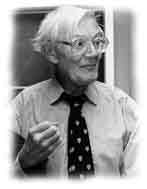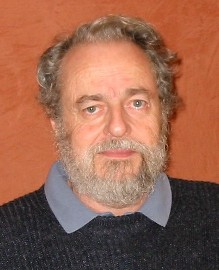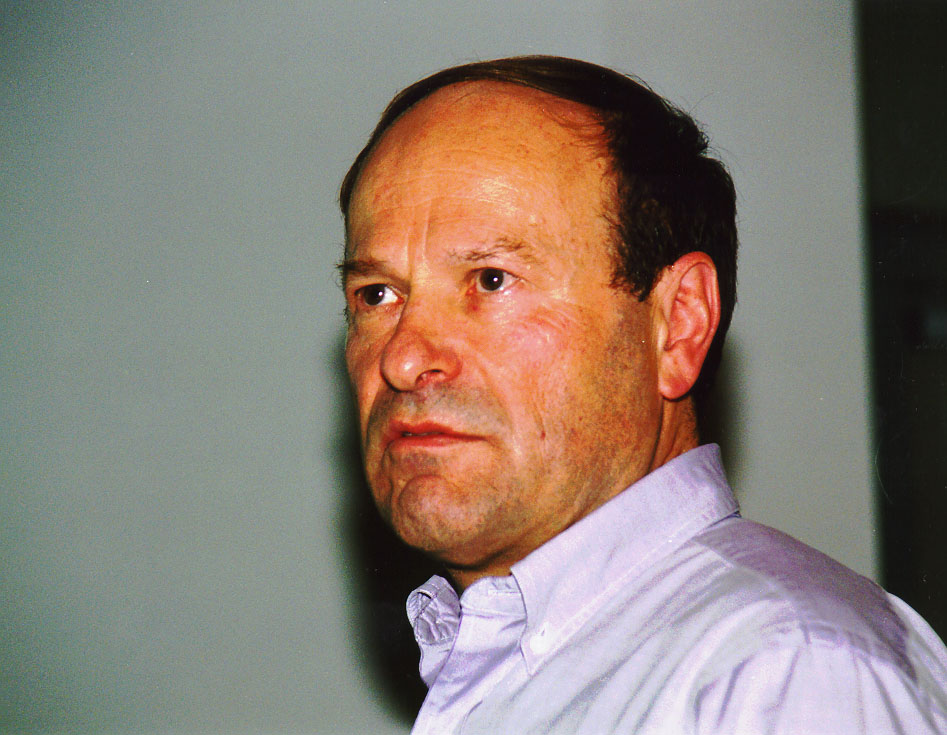|
 WILLIAM T. TUTTE (University of Waterloo) WILLIAM T. TUTTE (University of Waterloo)
TITLE: "Some adventures in Graph Theory"
PLACE: Centre de recherches mathematiques, Université de Montréal, Pavillon André-Aisenstadt, 2920, ch. de la Tour , Room 6214
DATE: Friday, November 9, 2001
TIME: 4:00 p.m.
ABSTRACT: In this lecture I tell of some episodes in my career as a graph theorist, showing how one piece of research can lead on to another. I expect to talk , among other things, of the dissection of rectangles into unequal squares, Hamiltonian circuits in planar maps, 1-factors in general graphs, chromatic polynomials and the enumeration of planar maps.
NOTE: There will be a cocktail after the lecture in Salon Maurice-l'Abbe, room 6245.
Professeur William Tutte (University of Waterloo).erlo
HIS WORKS: William Tutte works in graph theory and related areas of discrete math, and has done so for the last 60 years or so. This was the period of "coming of age" of graph theory; it changes from being a collection of rather easy theorems and some good open problems, to being a well-developed branch of math, stocked with rich and deep results. There were only a few prime movers who brought this about; the ones that come to mind are Erdos (doing extremal combinatorics), Wagner and Halin (doing structural graph theory and infinite stuff), and Tutte. Tutte took the opportunity to do initial, ground-breaking work in several new areas that were later to grow to major fields of discrete math. For instance, his matching theorem is the fundamental theorem of matching theory, an important branch of combinatorial optimization; in matroid theory, he proved two really deep important results (the characterizations of regular and graphic matroids), which are still pretty much the most important results of that subject; he made several other major contributions to matroid theory, including a form of what later became Edmond's matroid intersection theorem, and the discovery of the proper way to do matroid connectivity; for graphs and matroids, he came up with a polynomial which everyone else now calls the Tutte polynomial, which has most remarkable properties and connections with diverse fields (statistical mechanics, knot theory, colouring, and many others), serving to relate phenomena in these different fields; he proved many important results about connectivity in graphs (and matroids), such as his 'wheel' theorem, which is fundamental to much later work on graph connectivity; he did a great deal of work on enumeration of various kinds of pianar graphs, related to the four-colour theorem, which inspired later work on the subject. In summary, William Tutte grabbed all the best theorems while they were still up for grabs. But more than that; his work (both written and lecture) was really beautiful - it was always a fantastic experience to watch Tutte take on some problem, apply some strange algebraic machinery to it, and make showers of consequences fall out, in the most elegant way.
HIS STUDIES: professor William Tute was born in Newmarket, England. he studied at the University of Cambridge and obtained is Ph D. in 1948. Il arrived in Canada that year and joined the University of Toronto.He is a leader the field of graph thoery and matroid theory.
|
 The Centre de recherches mathématiques and the Fields Institute are pleased to announce the winner of the 2002 CRM-Fields Prize: John B. Friedlander of the University of Toronto. Professor Friedlander is one of the world's foremost analytic number theorists, and is a recognized leader in the theory of prime numbers and L-functions. He received his B.Sc. from the University of Toronto in 1965, an M.A. from the University of Waterloo in 1966, and a Ph.D. from Penn State in 1972. He was a lecturer at M.I.T. in 1974-76, and has been on the faculty of the University of Toronto since 1977, where he served as Chair during 1987-91. He has also spent several years at the Institute for Advanced Study where he has collaborated with E.Bombieri and many others. Friedlander is a Fellow of the Royal Society of Canada (1988), was an invited lecturer at the 1994 ICM in Zürich and delivered the CMS Jeffery-Williams Lecture in 1999. He has contributed significantly to mathematics in other ways, especially in Canada, through his role at NSERC (Mathematics GSC, 1991-94), as Mathematics Convenor of the Royal Society of Canada (1990-93), and as a Council member (1989-95) and Scientific Advisory Panel member (1996-2000) of the Fields Institute. He has served on the Editorial Board of the Canadian Journal of Mathematics and the Canadian Mathematics Bulletin for the past 4 years.
The Centre de recherches mathématiques and the Fields Institute are pleased to announce the winner of the 2002 CRM-Fields Prize: John B. Friedlander of the University of Toronto. Professor Friedlander is one of the world's foremost analytic number theorists, and is a recognized leader in the theory of prime numbers and L-functions. He received his B.Sc. from the University of Toronto in 1965, an M.A. from the University of Waterloo in 1966, and a Ph.D. from Penn State in 1972. He was a lecturer at M.I.T. in 1974-76, and has been on the faculty of the University of Toronto since 1977, where he served as Chair during 1987-91. He has also spent several years at the Institute for Advanced Study where he has collaborated with E.Bombieri and many others. Friedlander is a Fellow of the Royal Society of Canada (1988), was an invited lecturer at the 1994 ICM in Zürich and delivered the CMS Jeffery-Williams Lecture in 1999. He has contributed significantly to mathematics in other ways, especially in Canada, through his role at NSERC (Mathematics GSC, 1991-94), as Mathematics Convenor of the Royal Society of Canada (1990-93), and as a Council member (1989-95) and Scientific Advisory Panel member (1996-2000) of the Fields Institute. He has served on the Editorial Board of the Canadian Journal of Mathematics and the Canadian Mathematics Bulletin for the past 4 years. WILLIAM T. TUTTE (University of Waterloo)
WILLIAM T. TUTTE (University of Waterloo) HIS WORKS: One of the outstanding mathematical physicists active in Canada today, Professor Israel Michael Sigal, receives the CRM-Fields Institute 2000 Prize. Russian born, he obtained his bachelor1s degree at Gorky University in 1968 and later in life, his Ph. D. at Tel-Aviv University (1976). He is currently Professor at the University of Toronto. Apart from being a worldwide leader in his area of quantum theory, he is the leading expert on the analysis of the Schroedinger equation, which is at the heart of mathematical models of atoms and molecules. He also made groundbreaking contributions to the theory of interaction between light and matter, known as Quantum Electrodynamics. He has been rewarded with many honors. He is a Fellow of the Royal Society of Canada and received, in 1993, the John L. Synge Award for being an outstanding Canadian mathematician. These honors include several invited lectures at the International Congress of Mathematical Physics and the International Congress of Mathematics, and editorship of the following journals: Reviews in Mathematical Physics and Duke Mathematical Journal.
HIS WORKS: One of the outstanding mathematical physicists active in Canada today, Professor Israel Michael Sigal, receives the CRM-Fields Institute 2000 Prize. Russian born, he obtained his bachelor1s degree at Gorky University in 1968 and later in life, his Ph. D. at Tel-Aviv University (1976). He is currently Professor at the University of Toronto. Apart from being a worldwide leader in his area of quantum theory, he is the leading expert on the analysis of the Schroedinger equation, which is at the heart of mathematical models of atoms and molecules. He also made groundbreaking contributions to the theory of interaction between light and matter, known as Quantum Electrodynamics. He has been rewarded with many honors. He is a Fellow of the Royal Society of Canada and received, in 1993, the John L. Synge Award for being an outstanding Canadian mathematician. These honors include several invited lectures at the International Congress of Mathematical Physics and the International Congress of Mathematics, and editorship of the following journals: Reviews in Mathematical Physics and Duke Mathematical Journal.